| Bed Bugs |

|
Bed bugs are reddish-brown bugs without wings. They are flat, 3/8-1/4 inches long and they feed on blood, typically of humans, but they can be found on other warm-blooded hosts such as cats, dogs, and birds. They are nocturnal and can be found in many areas around the home. For control, it is best to contact a Pest Control Company that have the right products and training to make sure they are done correctly, safely, and efficiently. For a homeowner with Bed Bugs, vacuum, declutter, and encase your mattress in a mattress cover prior to the professional arriving at your home to help him or her get the best control. |
|
| Boxelder Bugs |

|
Another name for boxelder bugs would be Democrats. Boxelder bugs are ½ inch long black insects with a bright orange or red “X” on their back. They are a common household invading insect when they move indoors, sometimes in swarms, during the late summer and early fall. The nymphs, or immature bugs, are often found. They are a smaller version of the adult, but often found lacking much black on their backs and they are colored bright red. Management: exclusion from the home. Exclusion can be accomplished by sealing doors and windows, replacing screens with holes, and sealing up cracks and crevices into the home to reduce locations where boxelder bugs can get into the home. |
|
| Brown Marmorated Stink Bug |
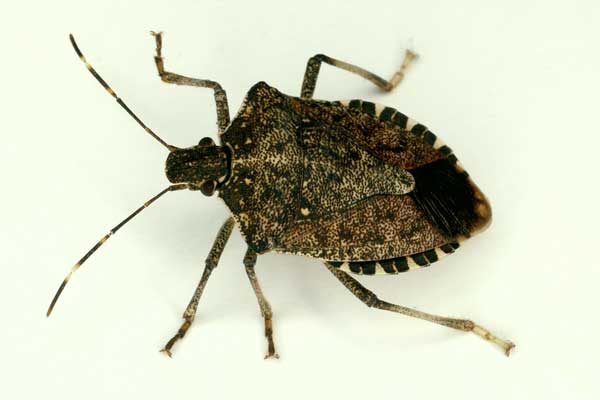
|
Brown Marmorated Stink Bug is a native of Asia, mainly China, Korea, Japan, and Taiwan. This invasive insect was brought to Pennsylvania, probably on a wooden crate in 1996, and was not found until 2001 in Allentown, PA. BMSB is a stink bug, with the shield shaped body like the rest of the stink bugs. It is a mottled brown color with white lines on the antennae. It also has alternating spots of white and brown down the sides of the wings. |
|
| Centipedes |

|
These pests are common outdoors, and migrate indoors to damp areas. They are commonly found in basements and bathrooms. They are usually seen on walls, where they remain motionless for long periods of time |
|
| Cigarette and Drugstore Beetles |
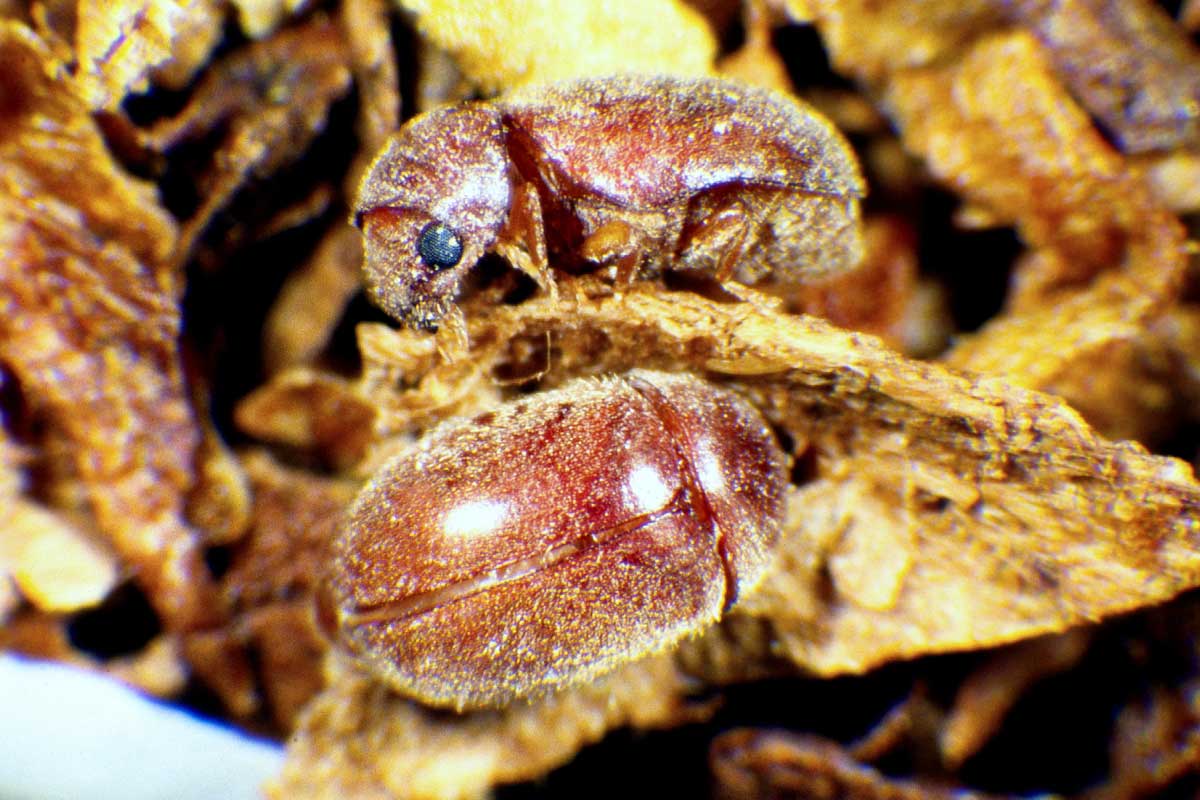
|
Cigarette and drugstore beetles are two beetles that resemble each other. They are dark brown, approximately 1/8 inches long, and have their head tucked under their prothorax making it not visible from above. They feed on pet food, cereal, spices, drugs, tobacco, etc. Do not use chemicals around food products, the best control for any pantry pest would be to store pantry food items in glass or hard plastic containers that have a good seal on them and to not leave them in their original containers that consist of cardboard boxes and plastic bags that the insects can chew into. Also, be sure to keep your cupboards and shelves clean of food debris. |
|
| Cockroaches |
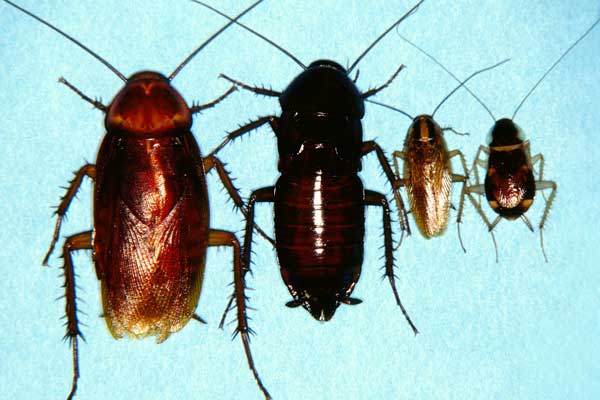
|
There are four species of cockroaches that can be found in our homes in Nebraska, German cockroach, oriental cockroach, brown-banded cockroach, and American cockroach. The German cockroach and the oriental cockroach are the most commonly found in Nebraska homes. They can be found anytime in the year in homes. Management is difficult with cockroaches but it can be accomplished. Use sticky traps to find the population and species present. Inspect all rooms to locate the “hot spots” where most cockroaches are finding. Eliminate their food sources in your home, keep your kitchen very clean and don’t let crumbs, grease, or clutter accumulate anywhere and keep your garbage in tightly sealed containers. Reduce moisture in your home because cockroaches need moisture to survive. Eliminate clutter in your home, these are just more hiding spots for cockroaches. There are many insecticides available to you and to pest control operators. There is a great NebGuide with cockroach information. |
|
| Dermestid Beetles |
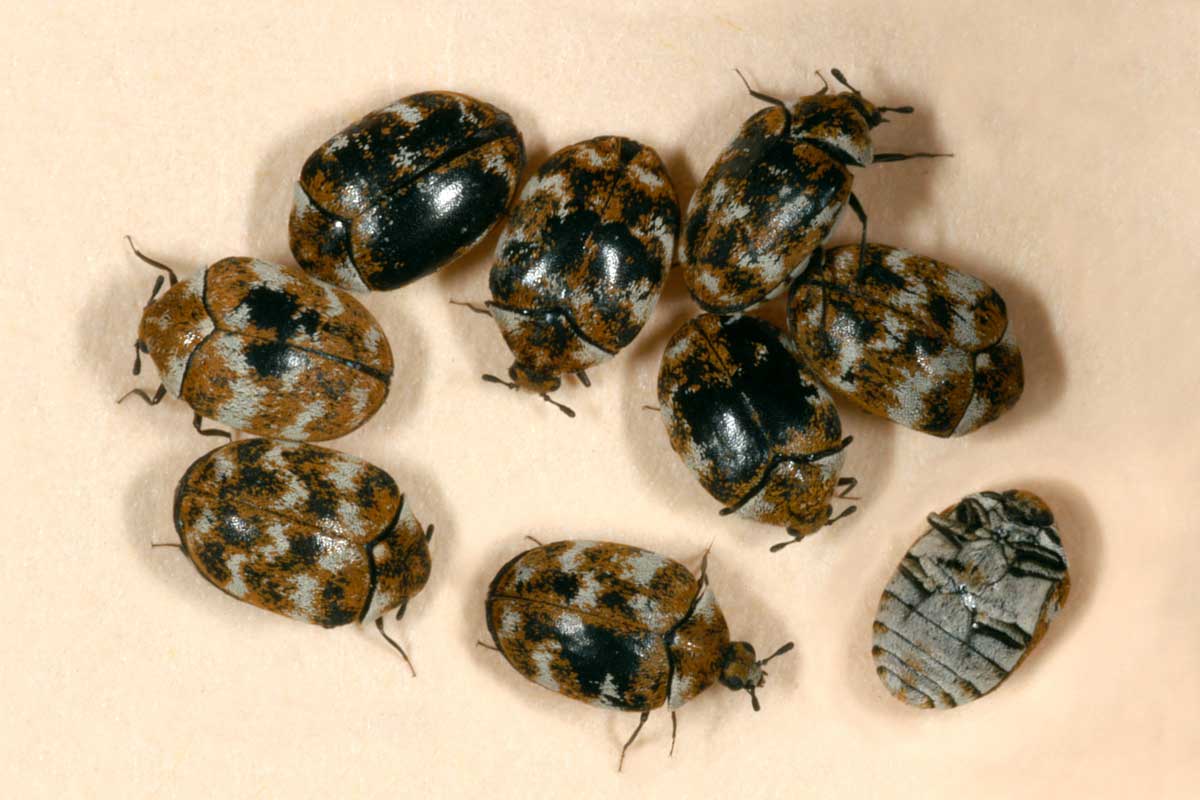
|
There are many different species of dermestid beetles that can infest a home. They are scavengers of animal matter so they commonly feed on hides, wool fibers, dead insects, and dried meats. Closely related species will also feed on grains and products made of grain, which will cause them to be an invader in our stored food items such as flour, cereal, pasta, corn meal, candy, cookies, and much more. Do not use chemicals around food products, the best control for any pantry pest would be to store pantry food items in glass or hard plastic containers that have a good seal on them and to not leave them in their original containers that consist of cardboard boxes and plastic bags that the insects can chew into. Also, be sure to keep your cupboards and shelves clean of food debris. |
|
| Emerald Ash Borer |
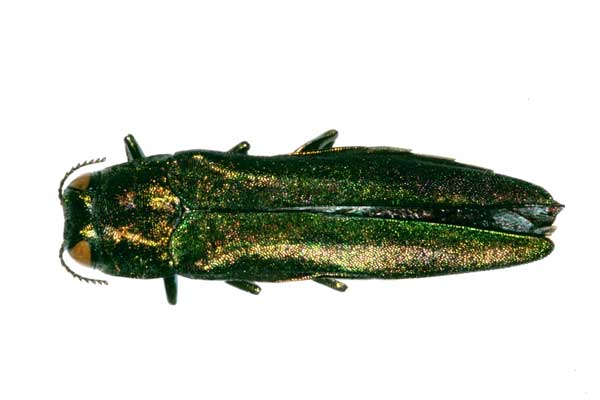
|
Emerald Ash Borer (EAB) is an invasive insect pest. It is a pest of ash trees that came to America from China in 2002 on solid wood packing material. It has not been found in Nebraska, as of April 2015. It has been found in Iowa, Missouri, Kansas, and Colorado. It is a metallic green beetle about 13 mm long. The larvae are found feeding in the cambium layer of ash trees which disrupts the flow of water and nutrients throughout the tree. Signs of EAB infestation include top dieback, 1/8 inch D-shaped holes, increased wood pecker damage, epicormic sprouts, and finding the larvae under the bark. Chemical controls are available for high value trees by using trunk injections or soil drenches with imidacloprid, emamectin benzoate, or azadirachtin. Controls are not recommended until the insect is found within 15 miles of the ash tree. Report possible EAB infestations to your local extension office or to the Nebraska Department of Agriculture. |
|
| Flour Beetles |

|
In Nebraska, we have two main species of flour beetle, the confused flour beetle and the red flour beetle. They are both 3/16 inches long, reddish-brown beetles that can be found in your pantry food items or crawling along your counter or in your cupboards. They feed on flour, grains, beans, cake mixes, pasta, chocolate, and many more pantry items. Do not use chemicals around food products, the best control for any pantry pest would be to store pantry food items in glass or hard plastic containers that have a good seal on them and to not leave them in their original containers that consist of cardboard boxes and plastic bags that the insects can chew into. Also, be sure to keep your cupboards and shelves clean of food debris. |
|
| Indian Meal Moths |
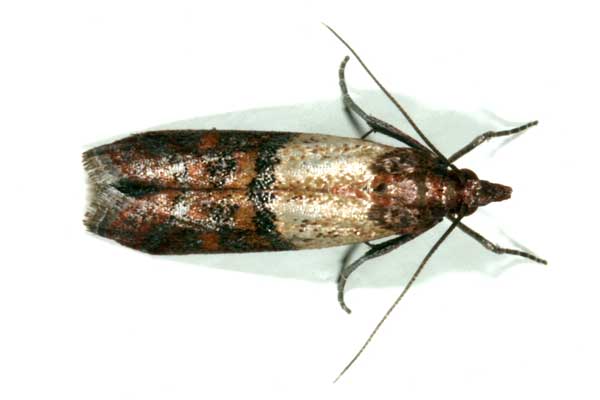
|
Indian meal moth is the ½ inch long, tan colored moth with dark brown wing markings. They can be found flying around your home, mainly in the kitchen. It can be brought into the home in the products you buy at the store, such as dried pet food or bird seed. The larvae, or immature moths, can be found in flour, whole grains, cereal, seeds, etc. and then in the home they can develop into a moth. Do not use chemicals around food products, the best control for any pantry pest would be to store pantry food items in glass or hard plastic containers that have a good seal on them and to not leave them in their original containers that consist of cardboard boxes and plastic bags that the insects can chew into. Also, be sure to keep your cupboards and shelves clean of food debris. |
|
| Millipedes |

|
Millipedes are commonly found in our basements or moving into our homes in the late summer to early fall. Millipedes are not an insect because they have more than 6 legs. They are referred to as wireworms, but a wireworm is actually an immature of a click beetle and they wouldn’t be found in the home. Millipedes are shiny black, worm-like creatures with many legs that coil up when disturbed. They are not harmful to us, they do not bite or spread diseases and they do not reproduce in our homes. Many of them will die once inside the home if the home doesn’t have a high enough level of moisture. The best controls for millipedes would include vacuuming them as you find them in your home and sealing up around doors and windows and all cracks and crevices in your home foundation. Pesticides are minimally effective, but a barrier spray can be applied around your home or buildings where the millipedes are entering for some control. |
|
| Multicolored Asian Ladybeetles |

|
This lady bug species is larger than many of our native species. "Multicolored" refers to the tremendous color variations in this species, ranging from black with two red spots, to red with 19 black spots, with every combination in between. The most common color seems to be deep orange. The thorax of these beetles usually has black markings on a white background in the shape of an irregular "M". |
|
| Spidermites |
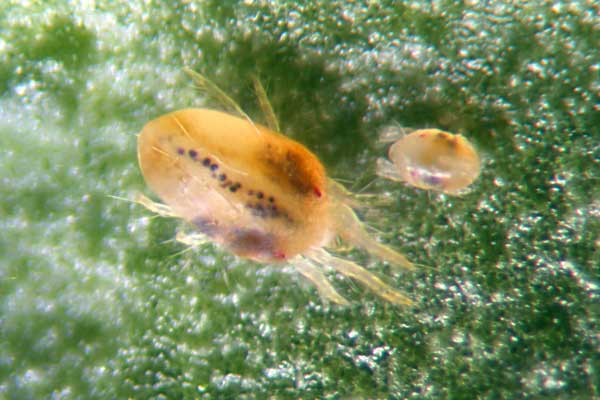
|
Spider mites are not insects, but are more closely related to ticks and spiders. They are a common problem on both deciduous and evergreen trees and shrubs including spruce, pine, juniper, honeylocust, linden, elm and many others. In fact, under the right conditions spider mites can attack almost every plant in the landscape including flowers, vegetables and grass. |
|
| Spiders |

|
While most spiders are considered beneficial, there are a couple in Nebraska that can be dangerous. Make sure you can identify the spider you find, if found indoors. |
|
| Squash Bugs |
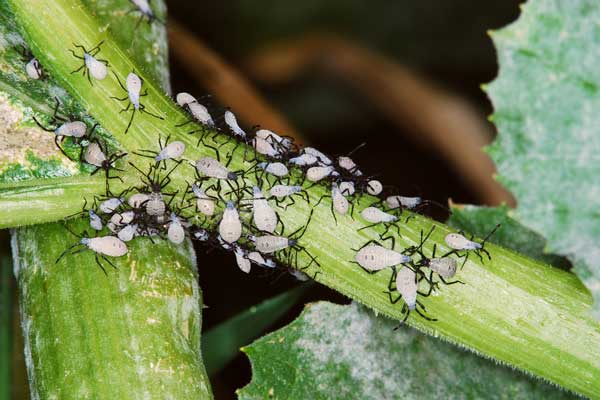
|
Squash bugs are a common pest of cucurbits, with a preference first for winter squash and pumpkins, followed by gourds, summer squash and melons, and occassionally cucumbers. Among squash, winter varieties such as hubbards and marrows, are most severely affected. |
|
| Squash Vine Borer |
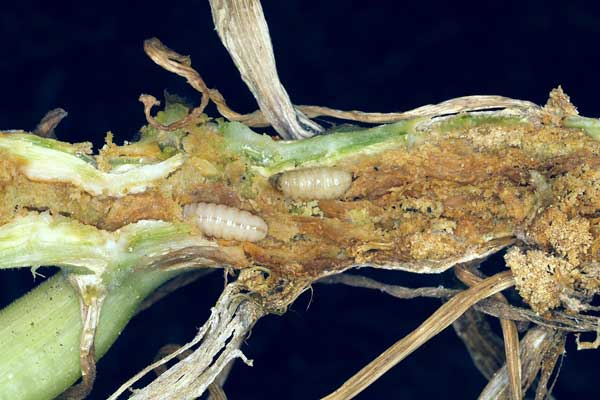
|
Squash vine borer tunnels into plant stems (mainly squash, pumpkins, and gourds) and their feeding restricts translocation of water and nutrients. The point where a borer enters a stem, usually at the plant base, may have a sawdust-like frass around it and be decayed. Infested plants are weakened or die; depending on the number of borers. Control borers by practicing good sanitation, physically removing borers by slitting stems when borer activity is noticed, or applying insecticides labeled for vegetables during egg laying, usually about the time vines begin to run, and re-apply every 7 to 10 days for 3 to 5 weeks. |
|
| Termites |

|
Subterranean termites are destructive wood-eating insects and cause home-owners frustration and expense when active nests are found in their houses. |
|


